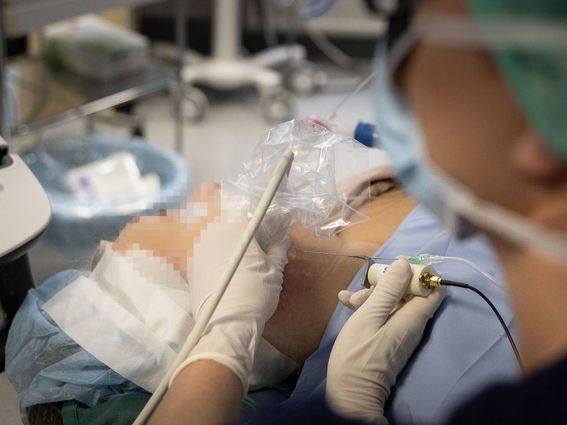Aalto University: A Milestone Achievement – HUS Conducts First Human Biopsy Using Aalto-Developed Ultrasonic Medical Needle
Several years ago a group of Aalto researchers started developing a new kind of medical needle. The goal is to avoid open biopsy, where a clinician removes a piece of suspicious tissue from the body for pathologic evaluation.
‘Samples with inadequate cells are a common problem in our work. They delay the diagnosis, cause extra cost, and may delay patient’s entry to treatment’, say HUS pathologist Jetta Kelppe. This is why there is a growing need to provide more and better sample material for diagnostic purposes.
To address these issues, the Aalto researchers developed a novel needle instrument that concentrates ultrasound energy at the needle tip to improve sample collection. Otherwise, the needle itself is the same that has been used previously.
‘With the help of the new ultrasonic needle, we might get a more reliable diagnosis and sometimes even avoid surgery. In addition, we might be able to plan more precise cancer treatment”, says Specialist in medicine, Katri Aro from HUS Department of Otorhinolaryngology, Head and Neck Surgery.
‘Biopsies are such a routine technique that a huge number of them are performed daily in hospitals world-wide. Anything that can enhance the outcome of this procedure would have a significant impact on everyday biopsies’, says Sanjeev Ranjan, Research Fellow at Aalto.

On 1 September, HUS clinicians used the ultrasonic needle for the very first time in a patient. They started preparing for the operation very early in the morning.
‘Years of hard work crystallized into 10 seconds of biopsy. After multiple rehearsals, the team was well-prepared for the operation, and everything went according to the plan’, says Aalto’s Doctoral researcher Yohann Le Bourlout.
A team of medical experts climbed a mountain
Minna Rehell and Mira Naukkarinen, Doctoral researchers at HUS, were part of the team of young researchers. Katri Aro feels very proud of them all. She feels as if they would have climbed a mountain and put a flag up there.
‘The accomplishment was not taken for granted considering the many safety aspects required from a surgical device, and it was made possible with a great team effort together with HUS. In addition to the Department of Otorhinolaryngology and a number of specialists there, the collaboration includes close teamwork with pathologists and radiologists in a multi-national team. Everyone has worked hard to make it happen. It was great to experience the success and the excitement. I hope the technology helps patients in the future’, says Professor Heikki Nieminen, who leads the project at Aalto.
‘Performing the biopsy with the ultrasonic needle does not differ that much from fine needle and core needle biopsies which I am very familiar with. After all the hard work and team effort, I am glad that the first clinical trial day was a success’, says Kristofer Nyman, the HUS Radiologist.
With anticipated benefits, the needle could bring improvements in the biopsy yield and quality, which would improve diagnostics in cancer management and help both clinicians and patients.
‘We are grateful to all the patients who have participated and will participate in this clinical trial. Their willingness to be a part of this important research is invaluable, says Ranjan.
New inventions do not become a reality overnight. The idea of a vibrating needle arose 2014 in Canada when Professor Nieminen, still a post-doctoral researcher at University of Helsinki, met Ken Pritzker, Professor in Pathology at University of Toronto. One of the research team members, Timo Atula, specialist in Otorhinolaryngology, had made his thesis on needle biopsies already in the 90´s, and has continued research on the topic since that. The medical experts pointed out that very little improvements in the diagnostic utility of needles has taken place over the last decades.
Meeting people with different kind of education and background knowledge, but still struggling with similar problems made fast development process possible.
According to an article published in 2021 in Scientific Reports, the vibrations of the medical needle are localised to the tip, so it does not affect any other tissue except a small region around the needle. In 2022, the first author of the article, Emanuele Perra defended his doctoral thesis, stating that ultrasound can extend the applications of medical needles to biopsy and even beyond to therapeutic applications.

